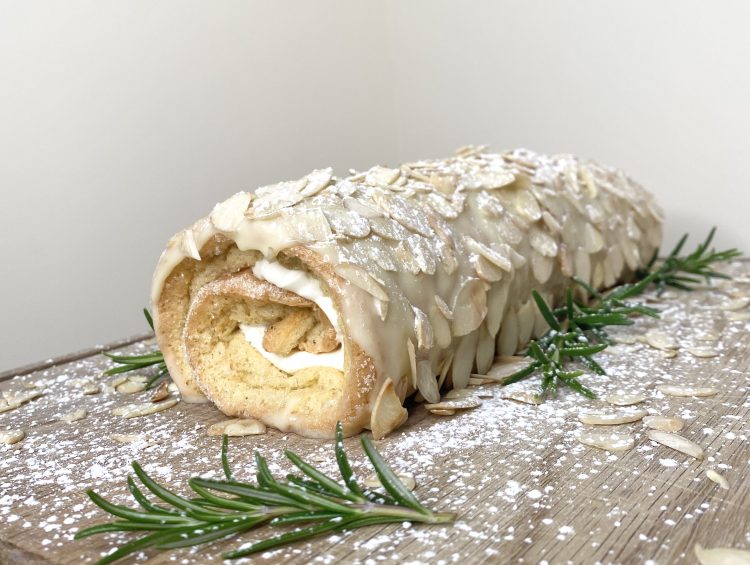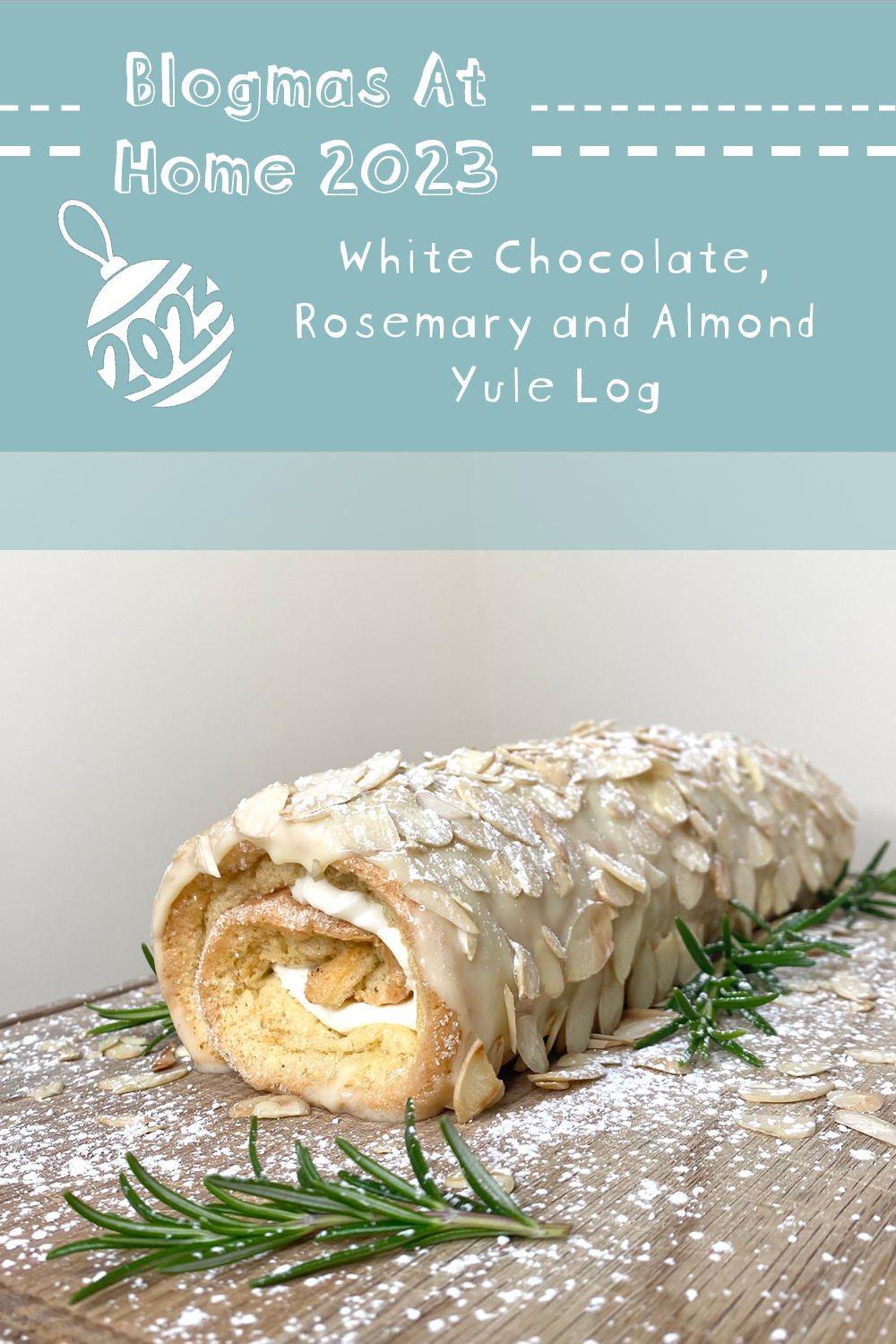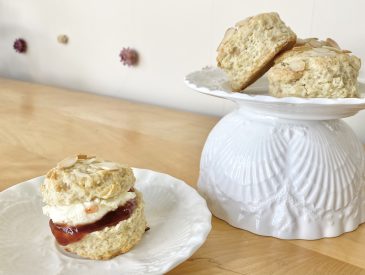🎄☃️✨ Welcome to Day 14 of Blogmas At Home! It’s 11 days until Christmas and love actually is all around. ✨☃️🎄
Growing up, my family was never really into the whole Yule Log thing. Don’t get me wrong- I would have been totally for it, I mean- chocolate cake? Copious amounts of icing? Yes, please. However, we typically had such an abundance of chocolate around during the festive season that we ended up going for non-chocolatey puddings on Christmas Day- think trifles, cheesecakes, that kind of thing.
A (kind of rogue) idea for a Yule Log-inspired, slightly less chocolate-heavy, Christmas dessert came to me recently, in a particularly hungry daydream. I am obsessed with the flavour combination of almond, rosemary and white chocolate. I know it sounds crazy, but trust me, it’s SO good. The savoury edge of the rosemary helps to temper the sweetness of the white chocolate, while also adding such a delicious depth of flavour. The almonds lend a nuttiness (obviously) to the whole thing, which compliments the creamy sweetness of the white chocolate perfectly. I think it might just be my favourite thing ever. Side note here: I can’t take credit for putting these flavours together- I learned about the combination from How To Cook That on YouTube (specifically, this video). Anyway, I decided that an almond, rosemary and white chocolate Yule Log would be delicious (spoiler alert: I was absolutely right), but I also figured that it would be kind of festive in a slightly unorthodox way- I mean, what are rosemary sprigs if not tiny Christmas tree branches?
With that, let me introduce you to the more sophisticated (and significantly blonder), older sister of the traditional Yule Log: my almond, rosemary and white chocolate Yule Log. It would make an amazing, unexpected showstopper for a Christmas celebration, or even just a tasty teatime treat for those who are opposed to a mince pie. Here’s how to make it…
Table of Contents
- The Yule Log: Explained
- Ingredients
- Making the White Chocolate and Rosemary Ganache
- Making the Almond Sponge
- Making the Almond Cream Filling
- Assembling the Log
- Final Thoughts
The Yule Log: Explained
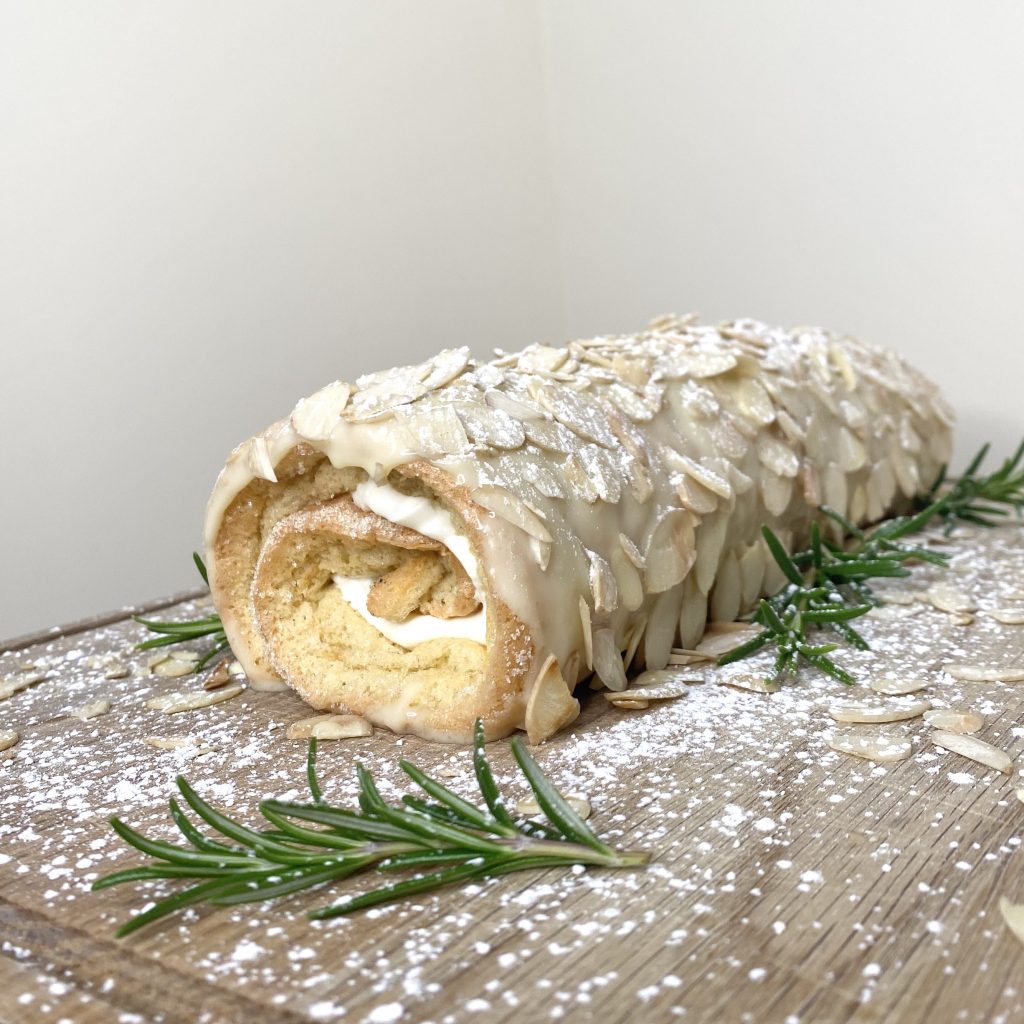
This Yule Log is comprised of 4 parts:
- Almond sponge
- Almond cream filling
- White chocolate and rosemary ganache
- Toasted almond decoration
That’s it! Yule Logs can seem SO daunting (that’s coming from someone who has spent her whole life being intimidated by the prospect of making a Swiss roll- this is actually the first one I’ve ever successfully made), but, if you break it up and follow the tips and tricks in this post, I promise it will be SO much easier than you expect. The photos in this post are actually from my first attempt at this recipe, which I feel proves that it really isn’t that tricky to master!
Ingredients
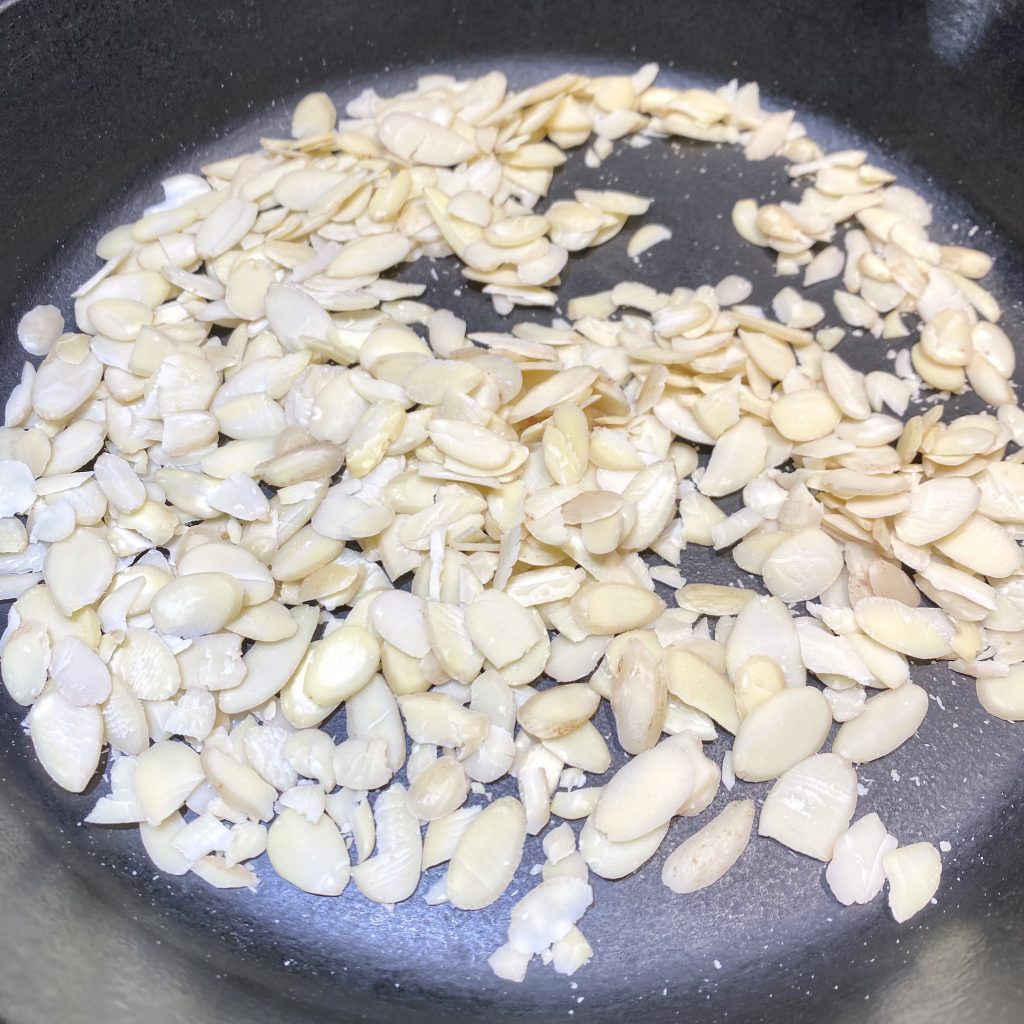
To make this Almond, Rosemary and White Chocolate Yule Log, you’ll need the following ingredients:
- Double Cream
You’ll need cream for both the ganache and the filling, so it’s a very important part of this recipe! If you are in the US, substitute heavy cream.
- White chocolate
Use a good-quality white chocolate, so you get the best flavour and texture.
- Fresh rosemary
You only need 2 sprigs of rosemary to make this cake, but I like to cut some extra sprigs to decorate the cake with at the end. Make sure that you wash it before using it!
- Fine sea salt
As is pretty standard in baking, I’ve included a pinch of salt in the cake batter- just to bring out the flavour of the other ingredients. However, slightly unusually, I’ve also included a pinch of salt in the ganache, just to help temper the sweetness of the white chocolate. It’s important to use a fine sea salt for this, so that it melts into the warm cream quickly and leaves everything perfectly smooth and silky.
- Caster sugar
You need caster sugar for this recipe, not only to make the cake batter, but to sprinkle onto the baking paper before you roll up the warm cake. The sugar helps to stop the cake from sticking to the paper, leaving you with a big mess on your hands when you go to unroll it. Don’t skip this step- it’s really important!
- Almond extract
I use almond extract in the cake batter, to really emphasise the flavour of the ground almonds, but also in the cream filling. There are a couple of more involved methods of getting almond flavour into cream, but this is by far the easiest.
- Vanilla extract
This sponge recipe is very egg-heavy, so, while the predominant flavour should be almond, it’s also important to counteract any potential ‘egginess’, which is never pleasant. A small amount of vanilla extract helps with that, while still letting the almond flavour shine through.
- Plain flour
It’s important to use plain flour here to achieve the right amount of rise with the baking powder. If you want to substitute self-raising flour, you will need to reduce the amount of baking powder accordingly.
- Baking powder
This helps the sponge to rise in the oven. Don’t skip it (or substitute it with bicarbonate of soda/baking soda- they aren’t the same and using them will affect the finished bake!).
- Ground almonds
Using ground almonds in the sponge not only helps to give the cake flavour, it also makes the sponge super moist and tender.
- Icing sugar
You need icing sugar to stabilise and sweeten the almond cream filling, but also to dust on top of the final cake and make everything all snowy and festive!
- Flaked almonds
For decorating the cake- these not only give the Yule Log a bark-like texture, but they also add even more almond flavour. If you’re pressed for time, you can actually buy flaked almonds ready-toasted, but toasting your own is super easy- just put them in a dry pan over high heat, tossing every now and then and keeping a close eye on them until they turn golden and smell deliciously nutty. Tip them out onto a plate/tray to cool completely before using.
Making the White Chocolate and Rosemary Ganache
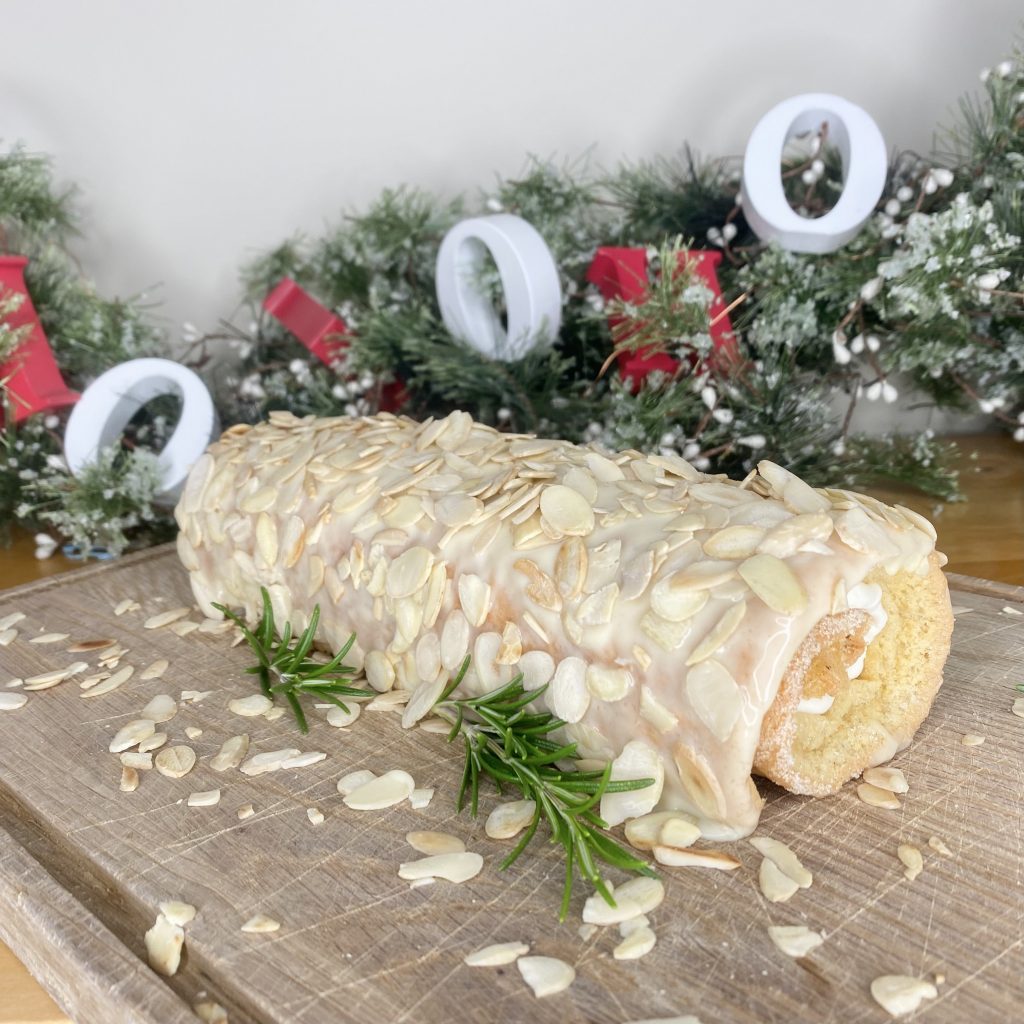
The ganache needs to chill in the fridge overnight, so make it the day before you want to assemble your cake. When I made this cake, I made my ganache a little too runny (as you can probably tell from the photo!), so I’ve adjusted the recipe to make a firmer, more spreadable ganache.
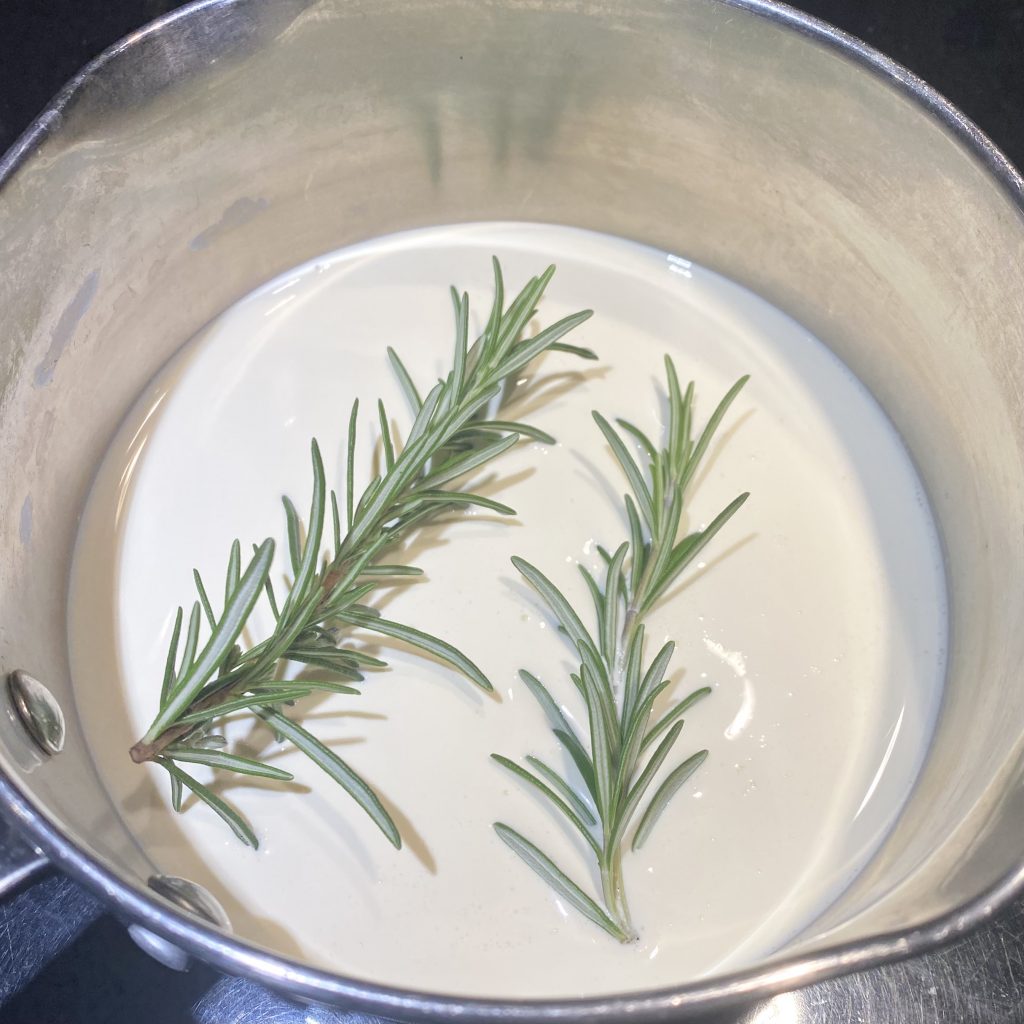
Start by infusing the cream with the rosemary. To do this, put the rosemary and the cream into a small saucepan over medium heat. Allow the cream to come to just below a simmer (you’ll see little bubbles, or a very subtle froth, forming around the edge of the pan when it is ready), then turn off the heat, cover the pan and let it infuse for 15 minutes.
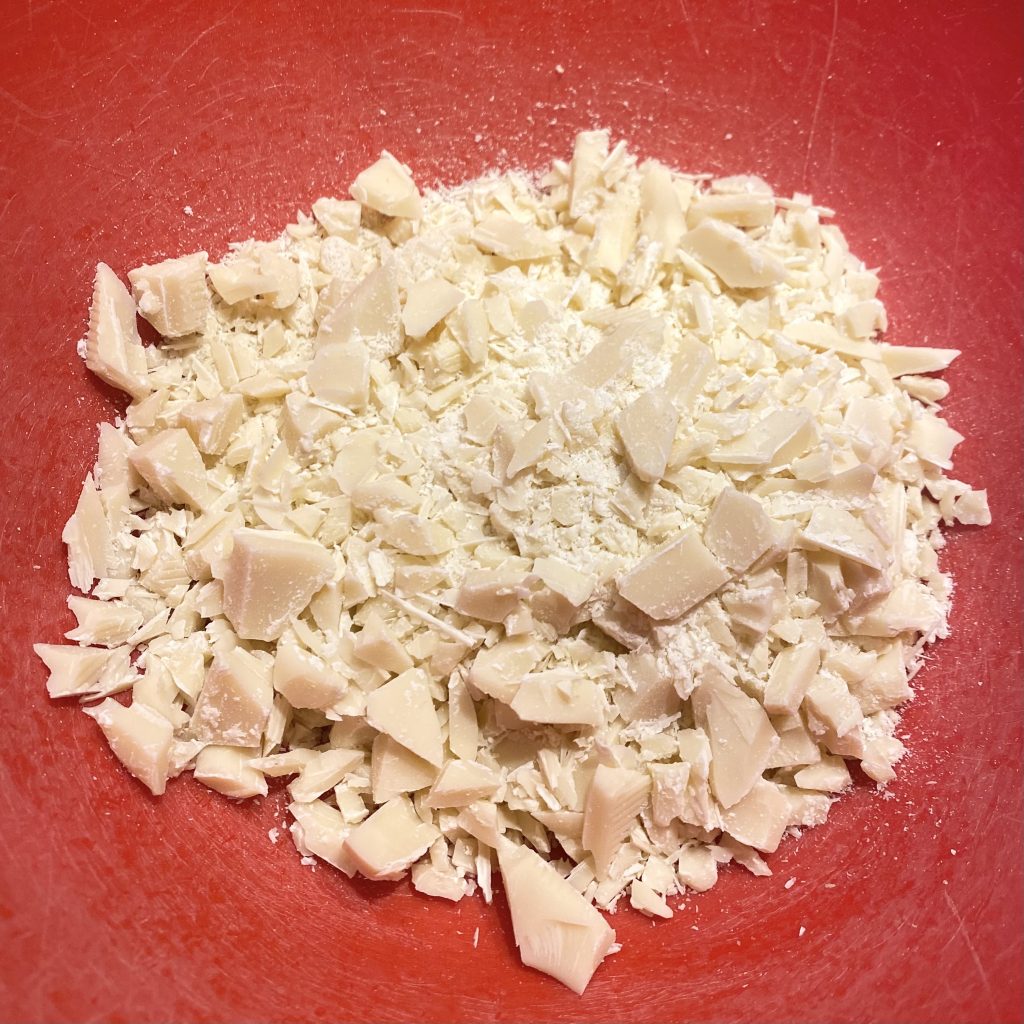
While the cream is infusing, chop your white chocolate. Make sure it’s finely chopped, so that it melts easily into the hot cream. Transfer the chopped chocolate to a heatproof bowl.
Once the cream has infused, remove and discard the rosemary sprigs. Then, bring the cream back up to just below a simmer, again. I know it seems a bit tedious to have to do this twice, but it is really important, so that you get the maximum flavour out of your rosemary and into your cake!
When the cream is hot again, stir in the fine sea salt, then pour the whole lot over the chopped chocolate. Allow it to sit for a minute or two, then stir until the chocolate has melted, the ingredients are completely combined and everything is smooth and silky. It’s important that you allow it to sit for a while at first, otherwise the cream will cool down too quickly and your chocolate won’t melt fully. If this does happen, you can rescue it by applying a little more gentle heat (either using a microwave/a bain-marie) and stirring frequently, until the ganache is completely smooth.
Once your rosemary-infused, white chocolate ganache is made, cover it with clingfilm. Press the clingfilm directly onto the surface of the ganache, to prevent it from forming a skin. Then, allow it to cool slightly before putting it into the fridge overnight to firm up.
Making the Almond Sponge
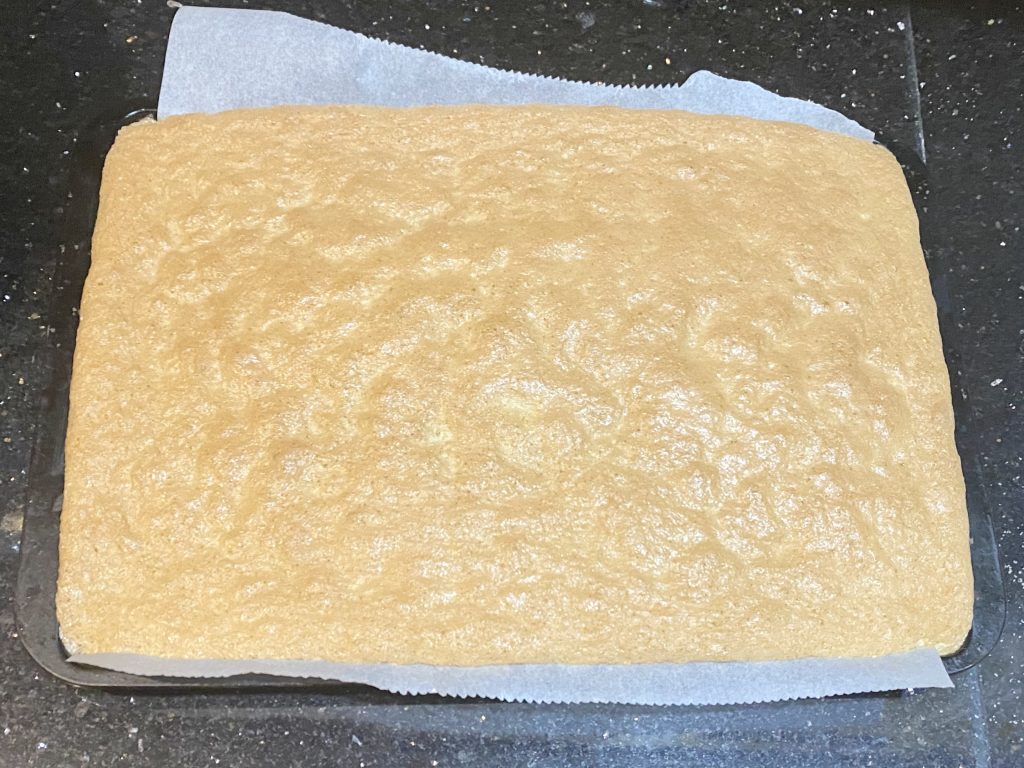
If you’ve never made a Swiss roll/sponge like this before, this recipe will definitely seem a little strange- there’s a lot of egg and very little of everything else! Don’t worry- just follow the recipe and you’ll be fine. In general, there are a couple of principles you want to follow:
- Keep as much air as possible in the batter
This sponge (as with most Swiss rolls) relies hugely on the air whipped into the eggs at the start to give it the perfect rise and fluffy texture. Whatever you’re doing, make sure you are preserving as much of that air as possible.
- Always roll the cake when it is warm
Cold cake is much more likely to crack and crumble when you try to roll it up. You want to roll the cake up while it is hot and allow it to cool completely in that ‘log’ shape before filling, to minimise your chances of breakage and end up with a perfect swirl.
Keep those two things in mind and you’ll be golden!
To make the sponge, start by preheating the oven to 180°C (conventional oven). Line a 23x32cm Swiss roll tin with baking paper and set aside. Fit a stand mixer with the whisk attachment (you could also use a handheld electric whisk, but I don’t recommend making this recipe by hand because the eggs need to be whipped a lot– trust me, your arms will thank you!).
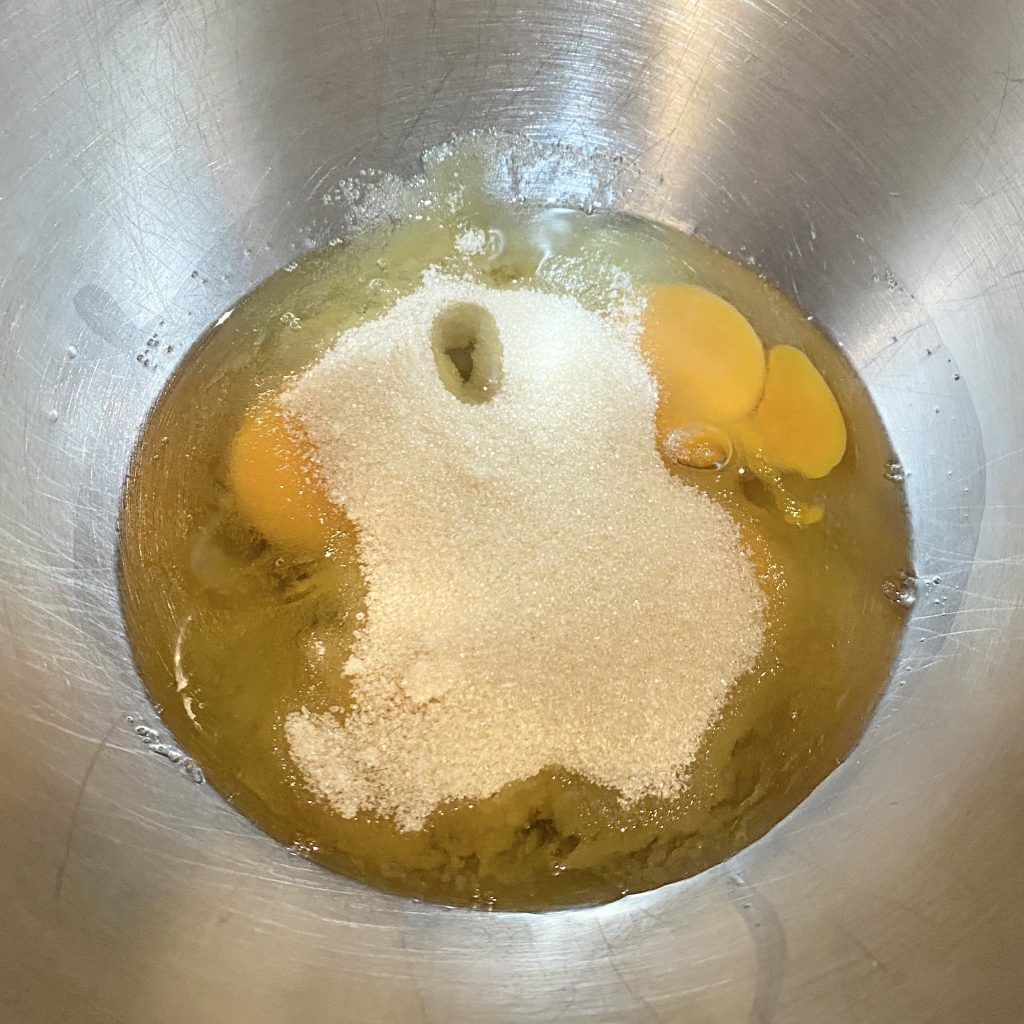
Place the eggs and the 80g of caster sugar into the bowl of the stand mixer. Whisk them together on high speed until the mixture is fluffy and pale- it should have tripled in volume and reached the ‘ribbon stage’- the mixture should fall off the whisk in a ribbon and you should be able to ‘draw’ a figure of 8 with that ribbon before it settles back into the rest of the mixture. One of the most common mistakes people make when baking this type of sponge is under-whipping the mixture at this stage, so be patient!
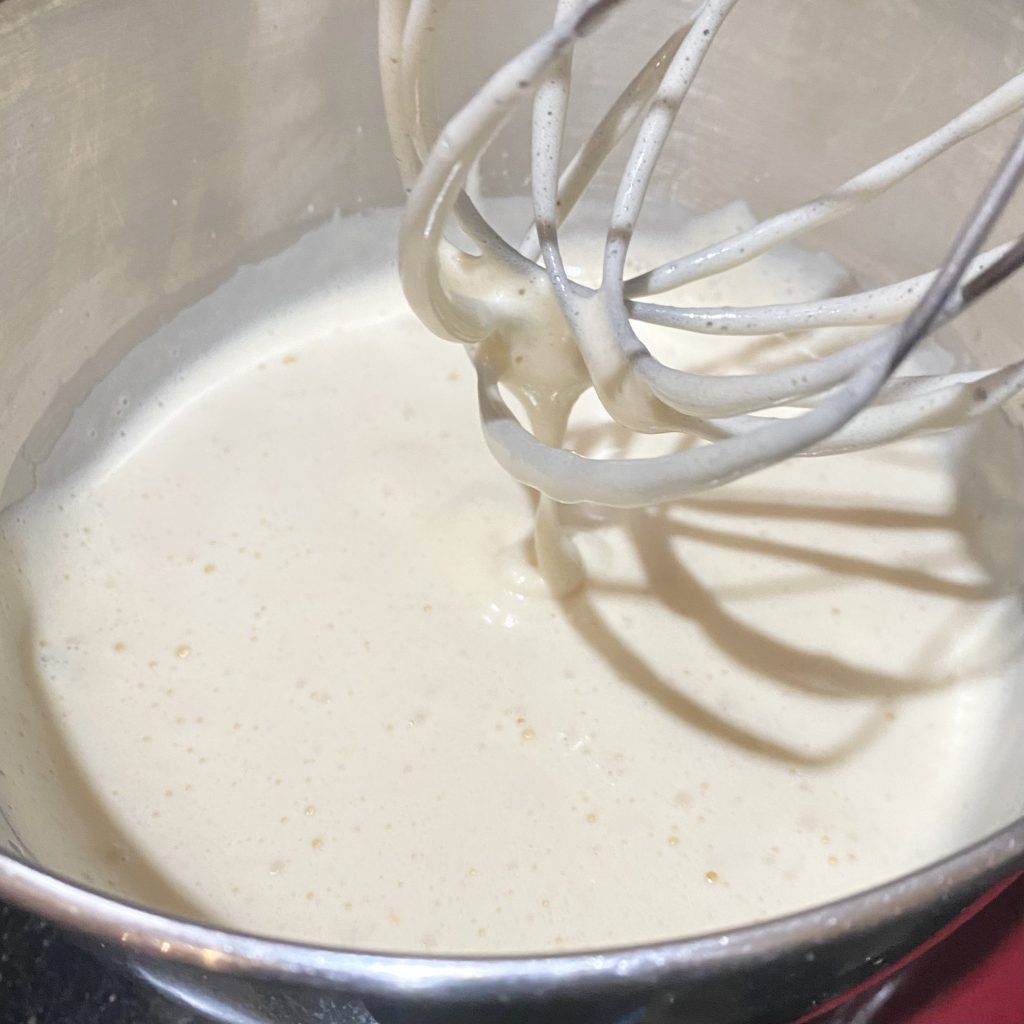
While the eggs are being whisked, you can measure out and sift the dry ingredients (the flour, baking powder and salt) together, into a separate bowl. Add the ground almonds (you don’t need to bother sifting them) and stir to combine. Set aside until the egg mixture is ready.
When the eggs and sugar are ready, add both of the extracts and whisk briefly to incorporate. You don’t want to add the extracts before this, because they will prevent the eggs from whipping up to their ✨full potential✨.
At this point, you can add the dry ingredients. Sprinkle them gently over the egg mixture- the goal is to knock out as little of the air as possible, so try to add the dry ingredients slowly and evenly over the surface (i.e. don’t plonk them all in at once!). Use a large, metal spoon to gently fold the dry ingredients in, until no streaks of flour remain. Metal spoons are best for this, because they ‘cut’ through the mixture more cleanly than a rubber spatula and, because of this, they knock out less air. Don’t forget to get right down to the bottom of the bowl when you’re folding the ingredients together, because some of the flour will inevitably end up there!
At this point, your sponge batter is ready! Pour it into the prepared tin and gently level it out with the back of a knife/an offset spatula- still being careful not to knock too much air out. Bake the cake in the centre of the preheated oven for 15-17 minutes, until the cake is golden and just firm to the touch.
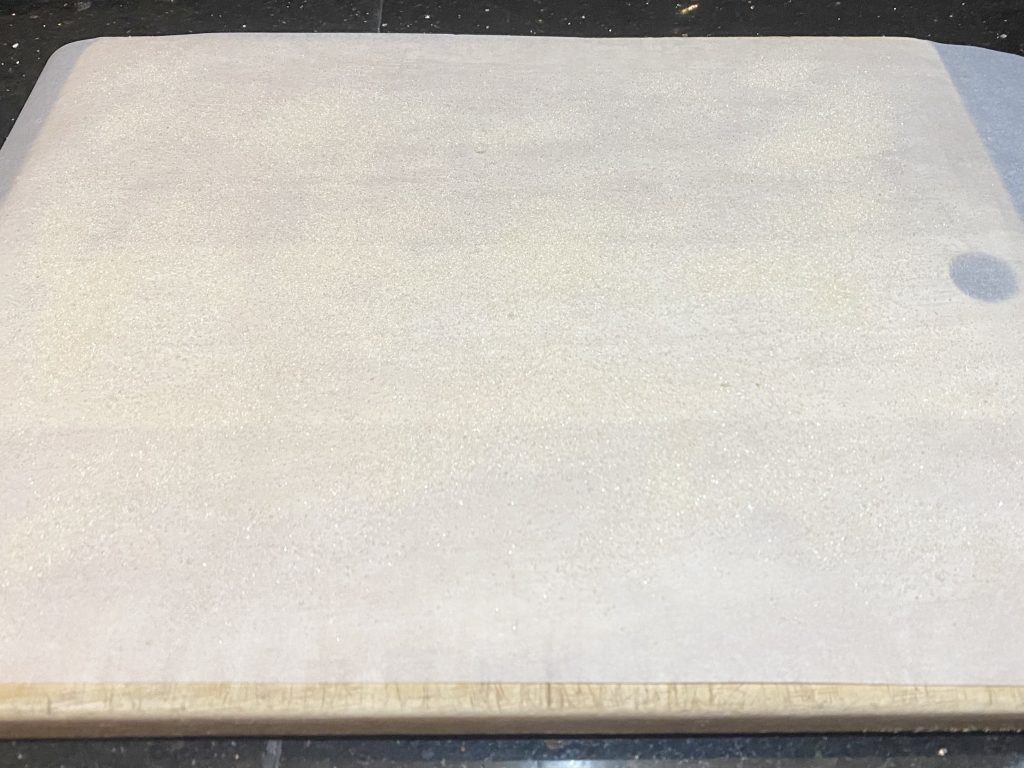
While the cake is baking, cut a piece of baking paper that is slightly larger than the size of the tin and spread it out onto a clean work surface/large chopping board. Sprinkle it with the remaining 2 tbsp of caster sugar, making sure the surface is evenly covered. Don’t skip this step- it’s really important because it prevents the rolled up cake from sticking to the paper (which would be a mess and could ruin all of your hard work!).
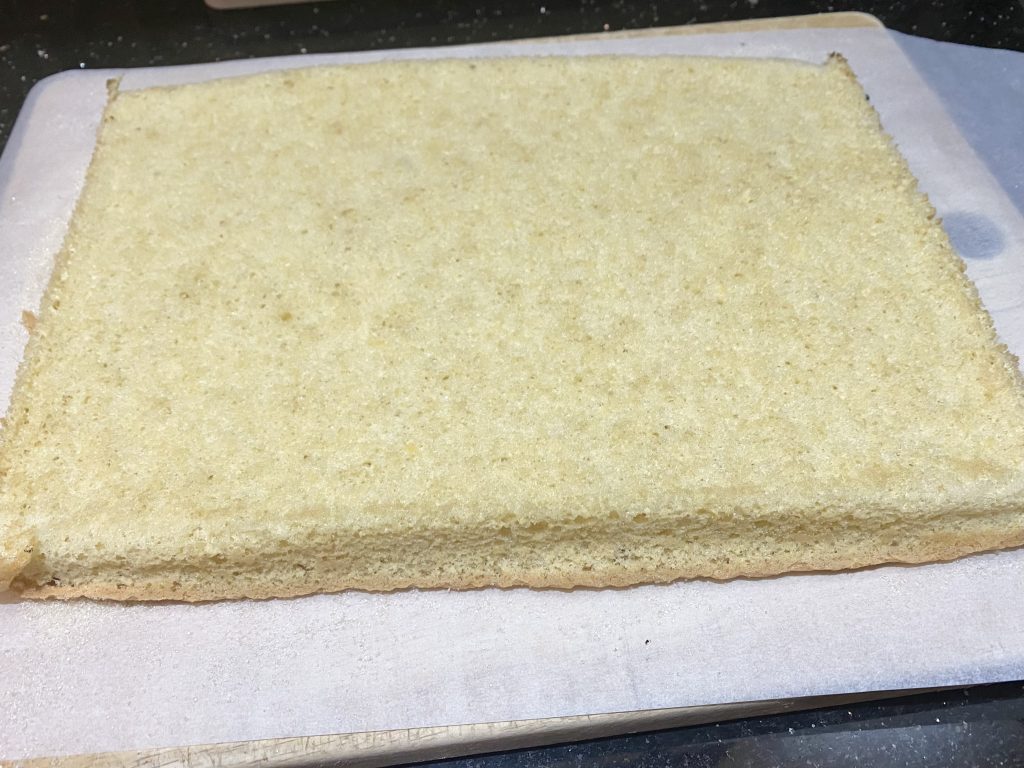
When the cake comes out of the oven, allow it to cool for 1 minute only before flipping it out onto the sugar-coated baking paper. Don’t leave it any longer, or you run the risk of your cake being too cold to roll and cracking when you try! Gently peel the top layer of baking paper (the one you used to line the tin) off the surface of the cake and discard it. Then, tightly roll up the cake. Start at one of the shorter sides and use the baking paper to help you roll it up nice and evenly. The tighter you roll it, the more defined the ‘swirl’ in the finished cake will be, so do it as tightly as you can, while still being gentle- the cake will be delicate, after all!
Once you have rolled the cake up, leave it to cool completely in that ‘log’ shape, before filling.
Making the Almond Cream Filling
The almond cream filling is the easiest part of this recipe- it’s literally only 3 ingredients! Make sure your icing sugar is sifted, so you don’t get any pesky lumps, then put all of the ingredients into a large bowl and whisk until stiff peaks form. Don’t go too far, or your cream won’t be smooth and will start to resemble butter, but make sure that it holds its shape. This is important, because otherwise it might ooze out of the log as you roll it up.
I like to use an electric whisk to do this, because it makes it so much quicker and easier, but you could absolutely whisk it by hand if you prefer.
Assembling the Log
When you are ready to assemble the cake, gently unroll the cooled sponge. Be careful, because it will be still delicate and you don’t want to crack it at this stage.
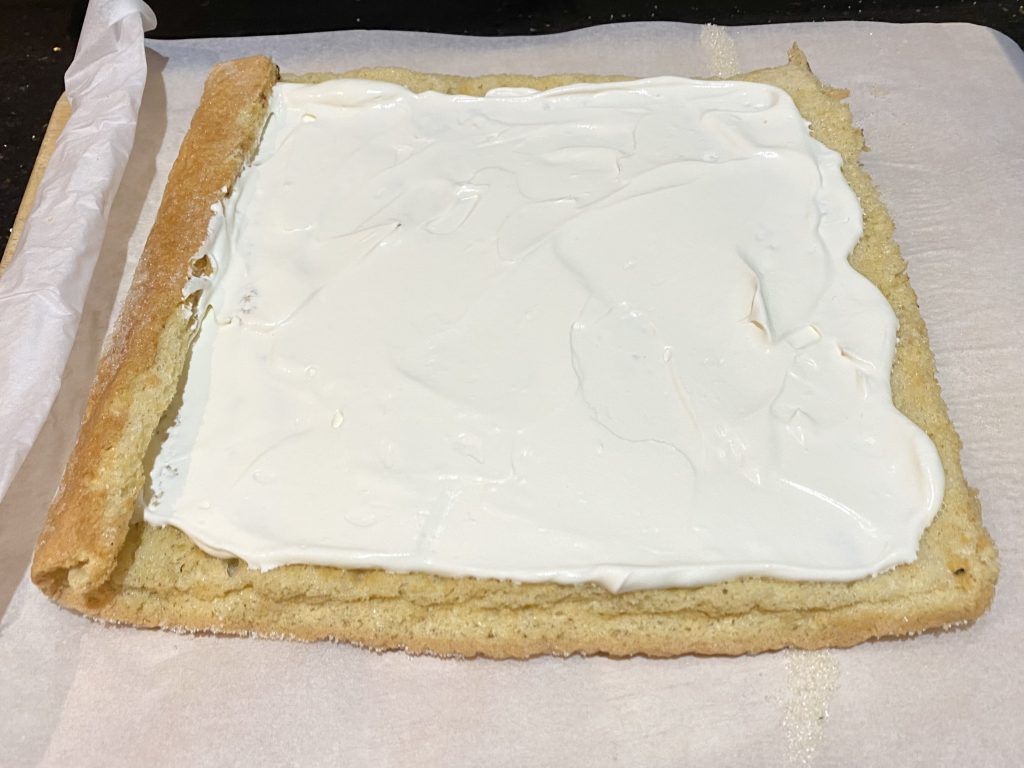
Spread the cream in an even layer all over the surface of the log. It will seem like quite a thin layer, but that’s exactly how it should be- any more and it will squidge out as you roll!

Once all of the cream is on, you can roll the cake back up. I like to use the baking paper beneath to help with this, so that I don’t have to touch the cake too much- just make sure you don’t roll it into the cake roll!
At this point, you will have a filled roll of cake. Success! The outside of the roll will be covered in lots of caster sugar from the baking paper- while it’s important to stop it sticking, there can be quite a lot of it leftover on the cake, which isn’t needed anymore. If you don’t mind it, you can leave it, but I use a clean, dry pastry brush to brush any excess off.
One quick note here: I left my roll as one straight log because I know my limits liked the simplicity of it. Often, traditional Yule Logs have ‘branches’ coming off them- if you want to do this, you can just cut one of the ends at an angle, then move the cut part to one of the sides, position the angled edge against the main roll.
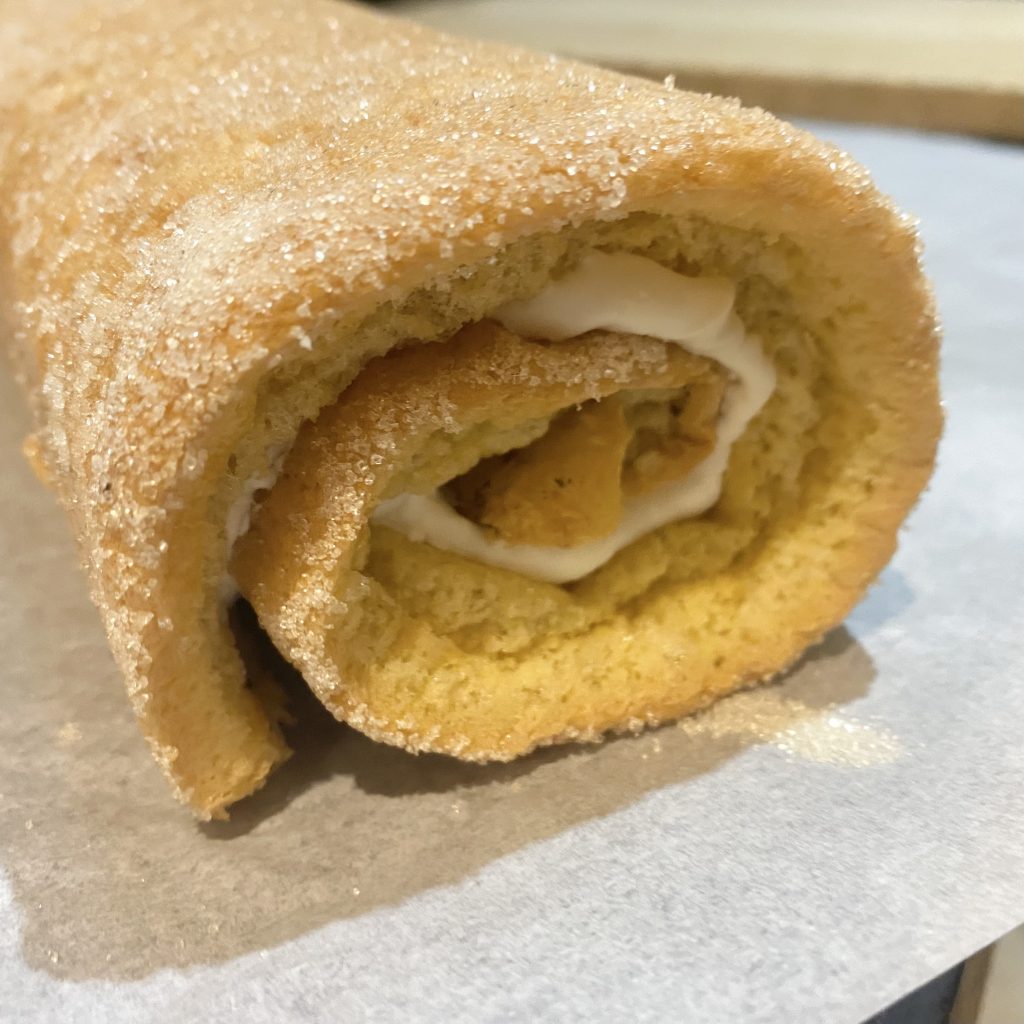
Once you’ve got your log assembled (and branched, if that’s your vibe) you can decorate i! Remove the white chocolate and rosemary ganache from the fridge, give it a quick stir to ensure it is smooth, then spread it onto the top and sides of the log. I use an offset spatula to do this, but you could just as easily use a knife, rubber spatula or spoon, if that’s what you have. I don’t cover the ends, because I like to see the pretty cake swirl, but you can if you would like.
Once your cake is covered in ganache, you want to cover all of the ganache-d surfaces with flaked almonds. You can sprinkle them over the top very easily, but you might have to resort to chucking handfuls at the sides to cover those parts.
To finish the whole thing off, add a few sprigs of rosemary here and there, for decoration, then give everything a final dusting of icing sugar ‘snow’, to make it ultra-festive.
The cake is best served immediately (as with all cakes, really), but it can be stored in the fridge for up to 3 days, if required (as long as the cream you used is still in date when you serve it!)- so you can make it ahead as your Christmas Day dessert.
Final Thoughts
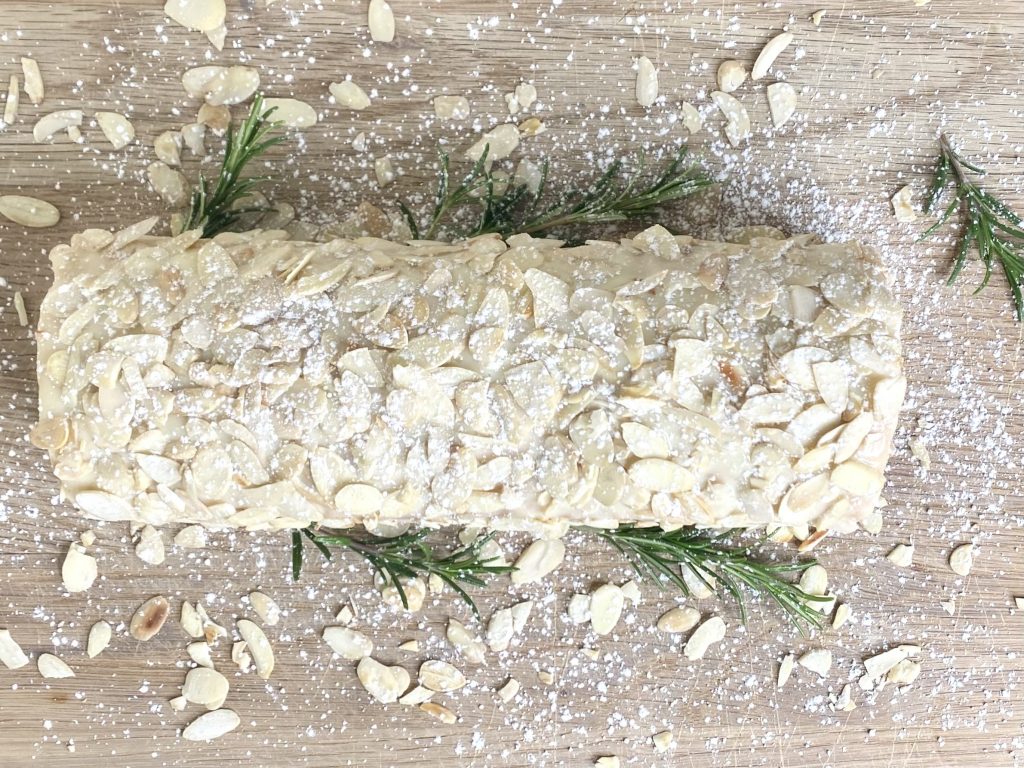
I know I’ve been saying it a lot recently, but I’m kind of… obsessed with this bake? I think it’s so elegant and unusual- it will definitely impress any guests/hungry family members this time of year. I also think, even though it’s not super traditional, it still has the fun of a Yule Log and plenty of festive flavour- I mean, rosemary is kind of pine-y and almonds are basically synonymous with Christmas at this point, right? Which reminds me- I’m definitely in my almond era this year. I think all of the Christmas bakes I’ve uploaded to the blog this year have been almond-y! What can I say? I am a marzipan girl THROUGH AND THROUGH. Anyway, I digress.
As I said at the start, making a Swiss roll can feel intimidating, but rest assured that this was only my second time ever making a Swiss roll (and my first successful time) and the pictures are all of my first attempt at this recipe. It’s a really fun, super rewarding bake, so don’t be put off by the extra hurdles. I have faith in you!
I hope you’ve enjoyed this post! I’d love to hear if you try out the recipe- let me know in the comments below!
Gemma
xxx
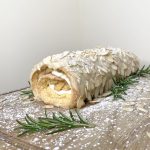
Almond, Rosemary and White Chocolate Yule Log
Equipment
- 23x32cm Swiss roll tin
Ingredients
For the white chocolate and rosemary ganache:
- 100 ml double cream
- 2 sprigs rosemary
- 150 g white chocolate
- 1 pinch fine sea salt
For the almond swiss roll cake:
- 4 eggs
- 80 g caster sugar, plus 2 tbsp for sprinkling.
- 1 tsp almond extract
- 1/8 tsp vanilla extract
- 50 g plain flour
- 1 tsp baking powder
- 50 g ground almonds
- 1 pinch salt
For the almond cream filling:
- 200 ml double cream
- 1 tbsp icing sugar, sifted.
- 1/4 tsp almond extract
To decorate:
- 80 g flaked almonds, toasted.
- Rosemary sprigs
- Icing sugar, for dusting.
Instructions
Make the white chocolate and rosemary ganache:
- Place the double cream and the rosemary sprigs into a small saucepan over a medium heat. Allow the cream to come to just below a simmer (you should see small bubbles form around the edges of the pan), stirring frequently. Remove the pan from the heat, cover and allow to infuse for 15 minutes.
- While the cream is infusing, finely chop the white chocolate and place into a heatproof bowl. Once the cream has infused, remove the rosemary sprigs and place the cream back over medium heat. Stir frequently until the cream reaches just below a simmer again, then stir in the salt and pour the whole thing over the chopped chocolate. Allow to sit for a minute or two, then stir until the chocolate has completely melted into the cream.
- Cover the bowl (place the clingfilm directly onto the surface of the ganache, to prevent a skin forming), then allow to cool slightly before putting into the fridge to set overnight.
Make the almond swiss roll cake:
- Preheat the oven to 180°C (conventional oven). Line the Swiss roll tin with greaseproof paper and set aside.
- Place the eggs and the 80g of caster sugar into the bowl of a stand mixer, fitted with the whisk attachment. Whisk on high speed until the mixture is pale and has tripled in volume- the 'ribbon stage'. Add the almond and vanilla extracts, and whisk briefly to incorporate.
- Sift the flour, baking powder and salt into a separate bowl. Stir in the ground almonds, then sprinkle the dry ingredients over the egg mixture. Using a large, metal spoon, fold in gently, until no streaks of flour remain.
- Pour the batter into the prepared tin and gently level it out with a knife/offset spatula. Bake in the preheated oven for 15-17 minutes, until the cake is golden and just firm to the touch.
- While the cake is baking, take a piece of baking paper that is slightly larger than the size of the tin and spread it out on a clean work surface. Sprinkle the 2 tbsp of caster sugar over the paper, making the surface is evenly covered.
- When the cake has finished baking, allow it to cool for 1 minute before flipping it out onto the sugar-coated baking paper. Peel the baking paper that was used to line the tin off the cake and discard. Starting at one of the shorter ends, tightly roll up the sponge, along with the sugared baking paper. Set the roll aside to cool completely like this.
Make the almond cream:
- Once the roll has cooled, place all of the ingredients for the almond cream filling into a bowl and whisk (I like to use an electric mixer) until stiff peaks form.
To assemble the cake:
- When you are ready to assemble the cake, carefully unroll the sponge. Spread the cream onto the cake in an even layer, then carefully roll the whole thing back up.
- Use a clean, dry pastry brush to brush off any excess caster sugar on the outside of the cake roll. Remove the ganache from the fridge, give it a quick mix to ensure it is smooth, then spread it onto the top and sides of the cake.
- Sprinkle the flaked almonds all over the surface of the cake, so that they stick to the ganache. Add a few sprigs of rosemary for decoration, then dust the whole thing with icing sugar. This cake is best served immediately, but it can be stored in the fridge for up to 3 days, if required.

